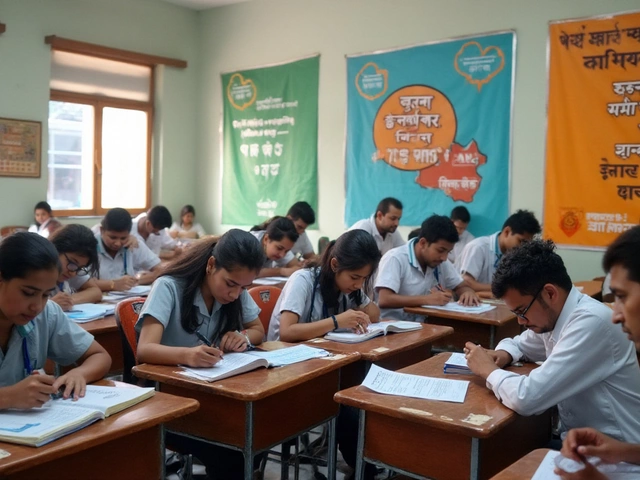
What Does JEE Stand For? JEE Meaning Explained for IIT Aspirants
Everybody's heard about the JEE if you’re anywhere near India's engineering world, but most don't actually know what it stands for. JEE means Joint Entrance Examination. It’s the test you need if you dream about studying at legendary institutes like the IITs and NITs. But that name—“joint entrance”—trips up a lot of people. It really just means one exam system, shared by all these top colleges, to pick out the brightest and most determined students.
This thing isn’t your everyday school test. Every year, millions go after this prize. Cracking the JEE is how teenagers turn their IIT dreams into reality. If you’re aiming for an engineering seat, understanding exactly what JEE covers and why it’s done in two stages (Main and Advanced) is the first step. Stick around, because there’s more to JEE than what coaching centers usually share—and knowing these quirks can give you a real edge.
- Breaking Down the JEE Name
- Why JEE Is a Big Deal for IIT Hopefuls
- What’s Inside JEE: Main vs. Advanced
- Surprising Facts and Exam Trends
- Practical Tips for JEE Preparation
Breaking Down the JEE Name
Most people throw around the term JEE all the time, but there’s still confusion about what it actually means. JEE stands for Joint Entrance Examination. That simple, three-letter term packs a lot of weight because “joint” hints at one main thing: this exam brings together different engineering colleges across India—especially the big names like the IITs and NITs—for a single selection process. No more separate, college-by-college entrance tests. This streamlines things for students and colleges alike.
The first JEE dates way back to 1960, when the Indian Institutes of Technology (IITs) started their own entrance exam. They didn’t want to just admit students based on school marks, because those can be all over the place, so they set up a common test to judge everyone by the same standard. Over the years, more institutes jumped in. In 2013, the old IIT-JEE merged with other exams to become the JEE we know today, which split into two parts: JEE Main and JEE Advanced. That’s why you see both names everywhere now.
In short, cracking the code of the JEE name is about understanding its real purpose: one big, standardized test for getting into the country’s toughest and best engineering programs. If you want a technical degree from an IIT or NIT, this is the first (and biggest) hurdle you’ll face.
Why JEE Is a Big Deal for IIT Hopefuls
Getting into the Indian Institutes of Technology has pretty much become the gold standard for engineering in India. There's no backdoor or special admit—if you want a seat, the only ticket is cracking the JEE. That’s why the IIT JEE gets so much attention, and honestly, a lot of nerves are tied up in it.
Let’s look at the numbers. Every year, around 1.2 to 1.5 million students register for JEE Main, but only the top 2-2.5 lakh get to try JEE Advanced. Out of those, just about 17,000 manage to grab seats in IITs. That’s like a stadium packed with people, and only the ones in the front row make it through.
| Stage | Approx. Number of Candidates | Approx. Number of Qualifiers |
|---|---|---|
| JEE Main (Registration) | ~1,400,000 | ~250,000 (for Advanced) |
| JEE Advanced | ~250,000 | ~17,000 (IIT seats) |
What makes JEE such a big deal is the outcome. Cracking it basically opens doors—not just for IITs, but also for NITs, IIITs, and other good engineering colleges. IIT grads end up working at the coolest tech companies, bag amazing research roles, or end up starting their own businesses. It’s wild but true: the JEE changes lives.
People start prepping years in advance. There are full-time schools focused just on JEE. Friends and families talk about it nonstop. And to be fair, the pressure is real. But the sense of achievement if you get through? Unmatched.

What’s Inside JEE: Main vs. Advanced
You’ll hear a lot about JEE “Main” and “Advanced”—two separate but linked exams. Know how they work, or you’re just shooting in the dark. JEE Main is the first filter. It’s used for admissions into NITs, IIITs, and some state engineering colleges. Only if you clear Main with a good rank do you get a shot at the legendary JEE Advanced, which is basically your ticket to the IITs.
Let’s break down how each one works:
- JEE Main: It’s held twice a year (around January and April) so you get two shots. The exam is entirely computer-based. It has three sections: Physics, Chemistry, and Mathematics. Each section carries equal weight. The questions are mostly multiple-choice with negative marking if you mess up.
- JEE Advanced: Only the top 2.5 lakh rankers from Main can even try Advanced. Now, Advanced is on a different level—tougher questions, deeper logic, less time to think. It’s split into two papers (Paper 1 in the morning, Paper 2 after a break). Both are mandatory. You’ll get a mix of MCQs, as well as Numeric Value questions. Unlike Main, the questions test if you really understand why things work, not just if you can memorize stuff.
Here’s a quick look at the key differences:
| Feature | JEE Main | JEE Advanced |
|---|---|---|
| Who Can Apply? | Anyone who finished 12th Boards | Top 2.5 lakh Main scorers |
| How Many Times? | 2 attempts yearly (max 3 years) | 2 attempts total (in 2 years) |
| Mode | Online (CBT) | Online (CBT) |
| Subjects | Physics, Chemistry, Math | Physics, Chemistry, Math |
| Question Types | MCQ, Numeric Value | MCQ, Numeric Value, More twists |
| Seats | NITs, IIITs, GFTIs | IITs only |
If you’re aiming for an IIT seat, don’t just focus on clearing Main. You’ll need to go deeper than shortcuts and formulas. Advanced is more about how you think under pressure and connect different ideas. The competition is fierce—last year, over 12 lakh students took Main, but only about 16,000 seats exist across all IITs. The numbers alone show how important it is to really get what JEE wants from you.
Surprising Facts and Exam Trends
Most people hear the word 'JEE' and think it’s just another test, but there’s a lot under the hood. For starters, did you know more than 1.2 million students typically fill out the JEE Main application every year? But only about 2.5 lakh make it to JEE Advanced. That’s a crazy filter—less than 1 in 5 even get to try for an IIT seat.
The type of questions has shifted a lot over time, too. A decade ago, memorizing formulas could get you halfway there. Not anymore. Now, JEE throws in plenty of concept-based and even some assertion-reason questions you won’t find in standard textbooks. Just this last year, there was a bigger variety of numerical value questions that needed clear step-by-step solving. The exam body loves to keep everyone guessing, so you can’t rely on a set paper pattern.
Here’s something that surprises a lot of folks: JEE is going digital. Since 2019, JEE Main happens entirely online. While you don’t need crazy fast typing skills, navigating the interface matters. Lots of students practice with mock tests on computers to get used to the timer and question palette.
Cut-offs, or the minimum required scores, change every year. It depends not just on how tough the papers are but also on student performance trends. In some years, even a score that seems decent isn’t enough for your dream branch because everyone else performed better. So, aim higher than the previous year’s cut-off—you can’t guess where it’ll land.
If you ever wondered about the success rate, here’s a kicker: Out of every hundred students who register for JEE Main, roughly 2 get into any IIT. The competition’s that fierce. But here’s the flip side—many top rankers weren’t always school toppers. Consistency and real practice matter more than magic IQ or raw marks from school tests.

Practical Tips for JEE Preparation
Let’s be real—cracking the JEE meaning mastering the Main and Advanced exams, not just learning formulas. Success is about smart studying, not just hard studying. Students who make it to IIT rarely pull all-nighters every day. Instead, they follow a plan.
First, know your syllabus inside and out. Most questions come straight from the NCERT books, especially for Chemistry in JEE Main. Don’t skip those, even if your coaching center tries to move faster.
- Make a doable schedule: Set aside at least 5 to 6 hours daily for JEE prep, but balance subjects. Don’t stack all Physics in one week and ignore Maths.
- Stick to quality problems: Don’t waste time solving tons of random questions. Try past 10 years’ papers—patterns repeat.
- Test yourself: Weekly mock tests are a game changer. NTA releases free online mock tests for JEE Main. Use them to spot what drags your score down.
- Clear your basics: If you can explain a topic to a friend, you probably know it well enough for the exam. Focus less on flashy tricks, more on the logic behind every step.
- Revise smart: Every topper swears by revision notes. Write your own brief notes, not those printed booklets. Flip through them weekly.
Manage stress by taking real breaks. Go for a walk, play something, talk to friends—brains work better with balance. Also, avoid FOMO (“fear of missing out”) from online groups arguing about the toughest material. Stick to your track. And if something feels too tough, ask teachers or use legit YouTube channels like Khan Academy for a simple explanation—don’t just Google and hope for the best.
Finally, never ignore exam-day basics: sleep well the night before, have all your documents ready, and arrive early. Last-minute panic can ruin months of effort. JEE prep isn’t about being a genius, it’s about being consistent and practical every single day.






Write a comment